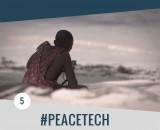Download
PDF
September 2014
As today’s headlines reflect escalating violence and tension around the globe, Conflicts of the Future: Trends and Responses takes a look ahead, identifying trends that will contribute to conflicts of tomorrow, and exploring how concerned citizens can act to prevent and respond to these conflicts.
Crumbling state legitimacy, illicit economic activity, and increased need for natural resources are the three themes this issue identifies as drivers of tomorrow’s conflicts. Despite this potentially grim outlook, our authors do not see tomorrow as bleak. As civil society members, key thought leaders, and on-the-ground peacebuilders, they instead trace possible paths to peace including innovative technology and community-based peacebuilding responses. Tomorrow will bring conflict, but we can work towards peace.
Dear Reader, As we finalize this issue of Building Peace, it feels as though the world is in greater need than ever of approaches to heal stark political divides, remedy […]
In his Nobel Peace Prize acceptance speech in 1987, Oscar Arias Sánchez, president of Costa Rica, remarked, “Peace has no finishing line, no final destination. It is like climbing a […]
Think global, act local is a bumper sticker the peacebuilding field would do well to take to heart. By supporting locally-led approaches to peacebuilding in specific conflict situations and as […]
The peacebuilding practitioner, John Paul Lederach, neatly summarizes in “The Moral Imagination” how we can use technology to increase the impact of peacebuilding initiatives: “Reach out to those you fear. […]
When we went through the . . . containment site after the revolution, we were demobilized . . . for five days. How can a man who went through a […]
In the locality of Kebkabiya, North Darfur, some 150 kilometers west of Sudan’s capital city of El Fasher, the Sudanese Development Initiative (SUDIA) is using low-tech solutions to build peace […]
Last year, authorities seized 1,300 kilograms of cocaine in Paris from an Air France fl originating from Caracas. In 2009, drug smugglers unloaded 10,000 kilograms of cocaine in Gao, Mali […]
Organized crime, long considered a law and order problem, is now becoming part of development policy and other agendas. This shift reflects growing recognition that armed violence and associated fragility […]
Diamonds and gold have an intensely emotional as well as monetary and industrial value. They symbolize love, romance, friendship, and far, far more. Human rights and environmental campaigners were onto […]
In 2007, the electronics industry became the target of activist groups who argued that downstream companies to artisanal mining were contributing to violence in the Democratic Republic of Congo (DRC). […]
Most people do not trust their governments. Surveys suggest that worldwide, across the general public and among decision makers, the figure is now below 45 percent. This growing deficit looks […]
Fifty years ago, Lake Chad in Africa had a surface area of 25,000 square kilometers. Today, it has less than 2,000. The surface area of the Aral Sea in Central […]
While there is still much we do not know about how to achieve, sustain, and maintain peace, it is clear that peace is necessary for a community to thrive. However, […]
In 1922, not long after the end of the “war to end all wars” and at the beginning of what has since proved one of the bloodiest centuries in recorded […]
We didn’t know what the word “tsunami” meant when it hit Sri Lanka on December 26, 2004. But our ignorance extended far beyond meteorological phenomena — ten years ago, lives […]
The title of David Kilcullen’s latest volume, Out of the Mountains: The Coming Age of the Urban Guerrilla, takes a leaf from Osama bin Laden’s book. According to a CNN […]
Big Men gives viewers fly-on-the-wall access to boardrooms of billion-dollar oil deals, intimate chats with African royalty, and strategy sessions with an underground militant group as the story behind big […]

